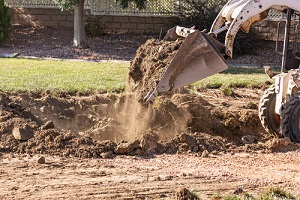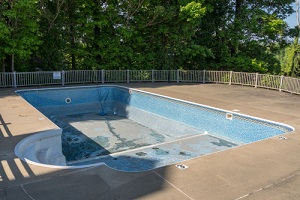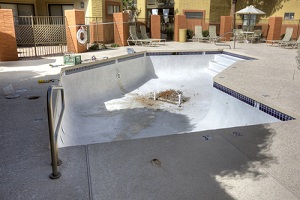 Swimming pools can be a lot of fun for some families, but not everyone enjoys having a pool on their property. Whether your pool is no longer useful to you, you are concerned about expenses and safety, or you are considering selling your home, there are plenty of reasons people choose to have their inground pool removed.
Swimming pools can be a lot of fun for some families, but not everyone enjoys having a pool on their property. Whether your pool is no longer useful to you, you are concerned about expenses and safety, or you are considering selling your home, there are plenty of reasons people choose to have their inground pool removed.
This guide will cover everything you need to know about the process, from making the decision to choosing the best approach and finding a good contractor.
Watch the Ultimate Guide to Inground Pool Removal
Prefer watching? Get all the essential insights on inground pool removal with clear visuals and step-by-step guidance. Watch the video now!
Why Should You Have Your Swimming Pool Removed?
Before you get your swimming pool removed, you will want to ensure that you are making the right decision. After all, once you have removed your pool, it will be very expensive to install a new one.
Here is a look at some of the benefits of removing your swimming pool to help you make your decision.
You Can Eliminate Safety Concerns
Swimming pool removal is a popular choice among young families who are concerned about the potential for their children or guests to drown while swimming or fall into the pool accidentally while playing in the yard.
According to the Centers for Disease Control and Prevention, drowning is the top cause of injury or death among American children aged 1 to 4; and it ranks third for children aged 5 to 19. These statistics illustrate how important it is to monitor children of every age closely while they are swimming and using the yard.
Another source of stress is staying on top of the measures needed to keep the pool area safe. Your municipality may have requirements pertaining to your pool fence and safety cover as well as the availability of safety equipment nearby.
If you have children, pets, or elderly people in the home, removing your pool can give you greater peace of mind, particularly while your children are playing outside.
You Can Avoid Expensive Maintenance
For many homeowners, pool maintenance is a significant expense. According to the 2021 Pool Maintenance Costs report from HomeAdvisor, it can cost an average of $122 per month or $1400 per year to maintain a swimming pool. This does not include factors such as water, electricity and repairs, which can bring the total yearly cost to somewhere in the range of $3000 to $5000.
In addition, for those who live in areas where a swimming pool cannot be used throughout the year, it can cost around $300 to $500 to open and close the pool at the beginning and end of the season. Closing and winterizing can include steps such as lowering the water levels, shocking the water, installing a cover, and closing and storing elements of the filter.
There is also liability insurance to continue to consider, which can add onto your monthly expenses as well.
You Want To Spend Less Time On Maintenance
 Costs aside, maintaining your swimming pool can use up a significant amount of your time, particularly if you are doing it yourself instead of hiring professional pool services.
Costs aside, maintaining your swimming pool can use up a significant amount of your time, particularly if you are doing it yourself instead of hiring professional pool services.
If you are tired of devoting so much time and energy to cleaning the pool area to keep debris from going in the water and clogging the filters, monitoring the pH levels of your water, and taking steps to prevent mosquitoes from nesting in the pool, removing the pool can provide you with more free time to use as you wish.
You Want To Free Up Yard Space For Other Uses
If your pool is occupying a significant amount of space, you may not have enough room left in your yard for other pursuits that you may enjoy more than swimming. For example, some homeowners choose to build a deck and create an entertainment area with a fire pit where they can enjoy the evenings with friends and family.
Gardening, particularly vegetable gardening, is growing in popularity right now, and many people want the greater control over the origin of their food that they can get from growing it in their yard. Homeowners with children might prefer to create a large grassy area for playground structures or sports in place of the pool.
Another consideration is the fact that real estate agents say pools that take up more than one third of the backyard can negatively impact the sales prospects of a home and limit the pool of potential buyers dramatically.
Your Pool Is In A State Of Disrepair
Many people choose to remove their pool once it reaches a point where it is so old or in such poor condition that it would be too expensive to bring it back up to standard. When a pool is no longer an attractive feature in the yard and it is not getting enough use to justify repair and maintenance expenses, removing it can be the smartest move from a financial standpoint.
You Can Raise Your Home’s Resale Prospects
Removing your swimming pool could place your home in a better position to sell. Many potential homebuyers are not looking for homes with pools because they are not willing to take on the safety concerns and expenses of having a pool. According to HouseLogic, a swimming pool only raises the value of a home if it is situated in a high-end neighborhood surrounded by other homes that have swimming pools, the pool does not take up too much yard space, the climate is warm enough to use the pool year-round, and the pool style fits in well with the rest of the neighborhood.
Pool Removal Methods
There are two main approaches to swimming pool removal: partial swimming pool removal and full swimming pool removal. Here is a look at what is involved in each method and the reasons homeowners choose them.
Partial Swimming Pool Removal
A partial swimming pool removal is a popular option for homeowners who are looking for a fast and affordable way to have their swimming pool removed and are not concerned about the impact on their home’s value or resale ability.
This process, which is also known as a pool fill-in, involves contractors drilling holes at the bottom of the pool that are several inches deep so it will not collect water during future rain. Then, the sides of the pool will be broken down roughly 18 inches from the top, and this broken concrete is placed inside the bottom of the pool. The pool is then backfilled and compacted carefully to prevent creating sinkholes.
 This approach involves breaking up less concrete and hauling away less debris than a full removal, which makes this a more affordable choice. It can also keep costs down when it comes to replacement dirt as there is less space to fill in. As a quicker process, the labor costs can also be lower.
This approach involves breaking up less concrete and hauling away less debris than a full removal, which makes this a more affordable choice. It can also keep costs down when it comes to replacement dirt as there is less space to fill in. As a quicker process, the labor costs can also be lower.
However, this is considered a riskier option because the yard could experience swelling or sinkage if the backfill and soil compaction are done incorrectly. This might also cause problems for your landscaping.
It is also important to keep in mind that the land where the pool existed will be considered unbuildable following a partial pool removal. This does not mean you can’t do anything with the space at all, but you will be limited to smaller decorations or landscaping rather than building other structures.
You will also be required to disclose to future buyers that a pool once existed on the site. In addition, should you or a new homeowner in the future want to build a pool, it will be necessary to fully dig up the old pool and remove it, then compact the soil once again.
Full Inground Pool Removal
A full inground pool removal is the method of choice for homeowners who want the freedom to do anything imaginable with their yard once the pool is gone. This is considered the most thorough option as it involves digging up and hauling away all of the materials that were used to build the pool, such as steel, gunite, vinyl, fiberglass and concrete. After these materials have been broken down and hauled away, the area will be filled with soil and compacted.
The fact that no pieces of concrete remain in the yard as they would in a fill-in means the space will be less vulnerable to seepage. In addition, because there are no limitations on what you can build in the area where the pool was, a full pool removal will not influence a potential buyer’s decision because it will be like the pool never existed.
Of course, with all of those benefits, it is important to consider the drawbacks. The main disadvantage of this approach is the fact that it costs more money because the process is more involved and there are higher labor and disposal costs. It is also important to keep in mind that it may take a few days longer than a pool fill-in depending on the position of the pool in the yard.
Watch the Ultimate Guide to Inground Pool Removal
Prefer watching? Get all the essential insights on inground pool removal with clear visuals and step-by-step guidance. Watch the video now!
What Is Involved In The Inground Pool Removal Process?
Here is a look at the steps that are involved in the inground pool removal process.
Looking At The Building Code
Before you can think about removing your swimming pool, you need to be aware of any permit and other requirements that your local building department has in place related to pool demolition.
Some areas have regulations that dictate certain aspects of the process, and it may also be necessary to obtain permits and pay related fees such as encroachment and recycling deposits. Although contractors generally take care of these details and include their costs in your quote, it is a good idea to confirm all of this.
Draining The Pool
 Regardless of which pool removal method you choose, the pool needs to be drained before any other steps are carried out. It is important to be aware of any local regulations regarding draining your swimming pool.
Regardless of which pool removal method you choose, the pool needs to be drained before any other steps are carried out. It is important to be aware of any local regulations regarding draining your swimming pool.
For example, you may have to neutralize the chlorine, remove copper from the water and discharge the water into a certain place; some areas ban the pumping of pool water into storm drains. Because swimming pool water often contains chemicals such as sediments, copper and chlorine that cannot go into waterways, it is important to be responsible when it comes to disposal.
Although draining the pool sounds simple, there is the possibility that the pool could end up floating if the proper precautions are not taken. When water builds up under a pool, the pressure that is created under the shell of the pool can exceed the pressure exerted by the pool’s weight, causing the entire shell to float. With full removals, this is generally not a major concern, but it is something to keep in mind with a pool fill-in.
Verifying The Location Of Utility Cables
Before the actual demolition stage of the project gets underway, contractors need to know where any pipes, wires and service cables are buried by the utility companies in the yard around the pool so they can avoid damaging them. In addition, any gas heaters that the pool uses must be disconnected before proceeding.
Removing Decking
At this point, it may be necessary to remove some of the decking surrounding your pool to facilitate the job. You might also need to remove some of your yard’s fencing so the heavy machinery that will be used for the demolition can access the area.
Swimming Pool Demolition
As you might expect, the actual demolition is one of the most complex parts of removing the pool, and this is true whether you get a full removal or a partial one. Skilled workers and specialized tools must be used to ensure safety.
If you have opted for a fill-in, this is when the holes will be drilled in the bottom of the pool to prevent water from collecting underneath it, leading to future problems. The top part of the walls will then be broken down. In a full removal, the whole structure will be broken down fully and the materials will be taken away. Your contractor might use tools like hydraulic breakers and pneumatic hammers to break the swimming pool’s floor and walls.
Backfilling The Pool Cavity And Compacting The Soil
After the swimming pool has been demolished, it is time to fill the area with soil and compact it to ensure the yard is left stable. Engineered backfill typically must be used for a full pool removal where a structure will be built over the area in the future. However, if the former site of the pool is going to be used for simple landscaping projects or gardening, the requirements are looser. During backfilling, the pool cavity will be filled with dirt, sand or gravel and then compacted until it resembles a normal yard.
Pool Removal Timeline
 Once you have made the decision to have your swimming pool removed, you may be eager to get the job done as quickly as possible so you can repurpose the yard. Here is a look at how long you can expect the process to take.
Once you have made the decision to have your swimming pool removed, you may be eager to get the job done as quickly as possible so you can repurpose the yard. Here is a look at how long you can expect the process to take.
Overall, pool removal is considered a relatively quick job, but there are several factors that will influence precisely how long it will take. Here is a look at some of the factors that can play a role in how soon your yard will be available.
Pool Removal Method
If you have decided to go with a full pool removal for a safer approach that will not impact your ability to sell the home in the future, you can expect it to take a few days longer than a partial pool removal. A full removal can take around 5 days on average, while a pool fill-in or partial pool removal can often be completed in just two or three days.
Required Inspections
If your municipality requires any type of inspections to be carried out before, during or after the pool is removed, you may have to wait depending on how busy the inspectors are. It may also be necessary to obtain permits before beginning your work; pool demolition contractors often deal with getting permits and explaining the engineering requirements that apply where you live. If you have any doubts, your contractor should be able to tell you how long you can expect this part of the process to take.
How The Area Will Be Used In The Future
Although the pool removal process itself can be done in less than a week, that does not necessarily mean that you will be able to start changing the yard right away. You may need to wait for sod replacement, grading and landscaping to take place before you can use the yard how you wish.
Weather And The Time Of Year
Swimming pools should not be demolished when the ground is frozen, nor should the job be carried out in inclement weather. Because swimming pool demolition is a project best left for dry days, the project might have to be delayed during rainy periods until favorable weather returns.
The Swimming Pool’s Location In The Yard
Another factor that can have a big influence on how long a pool removal takes is the position of the swimming pool in relation to the remainder of the yard as well as the street. It can take longer for contractors to get the heavy machinery they need into the yard if your pool is situated somewhere that is difficult to access. Having a pool that is surrounded by decking that also has to be removed can also add time to the process. However, if the pool is situated in a part of the yard that is easy for machinery to access, the job can be completed much faster.
The estimate you received from your pool removal contractor should provide information about the expected timeline of the project, along with its costs.
Pool Removal Costs
One of the biggest questions that most homeowners have before embarking on a pool removal project is how much it will cost. There are many factors that will determine how much you can expect to pay to have your pool removed. The biggest consideration is the type of pool removal.
 A pool fill-in or partial removal, which is the more affordable approach, can cost around $5000, according to data published by HomeAdvisor. However, it is important to keep in mind that this method does limit the way the land can be used in the future.
A pool fill-in or partial removal, which is the more affordable approach, can cost around $5000, according to data published by HomeAdvisor. However, it is important to keep in mind that this method does limit the way the land can be used in the future.
A full demolition, on the other hand, may cost somewhere in the range of $9000 to $19,000 because more labor and equipment are needed to remove the pool entirely. For many homeowners, this higher price can be worth it because the process provides additional peace of mind in the form of a more stable ground, and it also protects the value of your home when you sell it in the future.
The Pool’s Size
Larger pools can cost more money to remove than smaller ones. A bigger pool will have more material to haul away, which means that the costs associated with material removal will be higher. In addition, pool demolitions that require the removal of decking, landscaping, fencing or stairs also tend to cost more than straightforward pool removals.
The Pool’s Material
Another factor that influences how much you can expect to pay for your pool removal is the material the pool was made from. Some of the most expensive materials to remove are concrete and gunite because they tend to be very heavy, and it is more difficult to break them down and haul them away. Vinyl and fiberglass, meanwhile, have to be cut before being dismantled and hauled away, but they are lighter and therefore typically less expensive to work with.
Accessibility
Just as a pool that is difficult to access can take longer to remove, it can also be costlier. If contractors struggle to get the equipment needed to remove the pool into your yard, you can expect to pay more for their trouble. In contrast, a pool that is ideally situated for large trucks to back up next to them can lead to a significantly more affordable project.
The Tools Needed
It may also be necessary to factor in the price of the tools needed to carry out the project. If you are using a contractor, expenses related to tools tend to be included in their estimate. However, if you have decided to attempt this project on your own, you should expect to pay a few thousand dollars in equipment rental. You will probably need a truck to pour in fill, a dumpster to store debris and haul it away, and an excavator, jackhammer and sledgehammer.
Pool Removal Equipment
A pool removal is a very complex job that requires professional tools and equipment to carry out safely and correctly. Here is a look at some of the materials and equipment that will be used in the process.
Equipment For Breaking Down The Pool
 If your pool is very thick, such as those made of concrete or gunite, an excavator with a jackhammer attachment may be used to break up the concrete safely. Excavators have rubber tracks that allow them to minimize ground disturbance, and they can be equipped with specialized attachments to help overcome any challenges involved in the layout and structure of your pool.
If your pool is very thick, such as those made of concrete or gunite, an excavator with a jackhammer attachment may be used to break up the concrete safely. Excavators have rubber tracks that allow them to minimize ground disturbance, and they can be equipped with specialized attachments to help overcome any challenges involved in the layout and structure of your pool.
Many times, the excavator will be placed in a stationary position and its turret will be spun around to keep the operator at a safe distance from the breaking concrete. A skid steer is not considered a safe choice for breaking up the pool, but it may be used to move the concrete out of the swimming pool area once it has been broken up.
Many contractors will use a bobcat with a grapple attachment to pick the material up and bring it to the trucks to haul it away. The skid steer can also be equipped with a smooth bucket to move soil into the cavity where the swimming pool was and spread it evenly.
Equipment For Compacting The Soil
Compacting the soil to the type of density needed to provide stable ground is often carried out with a padded drum roller, or sheep foot roller. With its large vibrating drums and knobs, it can knead the soil efficiently and bind the dirt. This depends largely on the space available; if access is difficult, it is possible to use a plate compactor, but this requires a very experienced operator and can take more time.
A host of other equipment may also be used for swimming pool removal, including laser levels, rebar cutters and reciprocating saws.
Pool demolition equipment has the potential to cause serious damage to a home’s landscaping, sewer connection, driveway, septic tank, fencing and other aspects of the yard, which is why working with a professional pool removal contractor who has the experience to use the equipment safely and the know-how to access the area with minimal damage is essential.
Another positive of working with experienced contractors is that they will know the right type and size of equipment to use for your particular space.
Finding A Good Inground Pool Removal Contractor
These days, DIY projects are becoming increasingly popular, and it is not difficult to find tutorials on all manner of home improvement projects online. Although many of these tutorials make the task seem achievable, there is a big risk that inexperienced homeowners can injure themselves or others or seriously compromise the integrity of their yard when they attempt to carry out a pool removal project on their own.
For example, inexperienced homeowners who rent the heavy-duty machinery needed for the job could end up experiencing a major accident because they do not have a good command or understanding of the equipment. This could result in damage to plumbing pipes, septic tanks, sprinkler lines and other areas of the yard. They could even end up accidentally hitting gas or electrical lines and creating serious problems that will be costly to correct.
Therefore, choosing a good contractor is the best approach. Here is what to look for in a pool removal contractor.
Experience
The main reason you want to use a pool removal contractor instead of carrying out the work yourself is their experience, so it pays to choose a contractor who has been in business for many years. Ask friends, family or acquaintances who have recently had pools removed for referrals or search online for local pool removal services that have positive online reviews. Once you have narrowed down your list, ask potential contractors about their specific experience in the type of pool removal project you have chosen.
Insurance
 It is also necessary to ensure that the contractor you choose is fully insured to protect you if they make any mistakes during the demolition or one of their workers is accidentally injured while carrying out work on your property. You can ask the contractor to provide you with copies of their workers; compensation and liability insurance as well as their state contractor’s license; be sure to verify that the policies they show you are current.
It is also necessary to ensure that the contractor you choose is fully insured to protect you if they make any mistakes during the demolition or one of their workers is accidentally injured while carrying out work on your property. You can ask the contractor to provide you with copies of their workers; compensation and liability insurance as well as their state contractor’s license; be sure to verify that the policies they show you are current.
Permits
It is also a good idea to find out if the contractor you are considering will handle all of the details of getting permits on your behalf. Contractors who do this regularly can typically get permits quicker while avoiding some of the common problems that may be encountered in acquiring permits. It is also important to ask about this because if a contractor says they cannot get the permits, it could indicate that they do not have a lot of experience in pool removal.
Removing a pool without the required permits can lead to problems when you attempt to sell the home in the future or if your local municipality learns that you had your pool removed.
Get In Touch With The Professional Pool Removal Contractors
If you have decided that you would like to eliminate the worries and expenses associated with pool ownership and devote your yard to a different purpose, reach out to the Northern Virginia pool removal contractors at Dirt Connections. Our experienced team can advise you on the best approach for demolishing your pool and answer any questions you have about the process. We can also help you with utility disconnection, permits, hauling away materials, and leveling the yard.
Our company has more than three decades of experience in pool removal, which means that we carry out the work to a high standard and leave you with a yard that is safe and ready for whatever use you have in mind.
Summary

Dirt Connections was started with one goal in mind: providing quality residential and commercial construction services to clients on time and on budget. Reach out for more information on how we can support your next project.
For your convenience our estimates are free and by appointment. Call 703-940-9949 for a free estimate today!









































